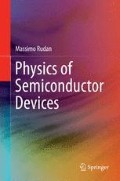Abstract
The mathematical model of semiconductor devices, derived in Chap. 19, is applied here to the description of two fundamental devices of the insulated-gate type: the MIS capacitor, whose most important implementation is the MOS capacitor, and the IGFET, whose most important implementation is the MOSFET. Both devices can be realized starting from either a p-doped or an n-doped substrate; only the first realization is illustrated here: the extension of the theory to the other one is immediate. The analysis of the MOS capacitor is carried out using the simple example of a one-dimensional device in steady state, with the hypotheses of non-degeneracy and complete ionization, that lend themselves to an analytical treatment. Observing that in a steady-state condition the device is in equilibrium, the theory needs the solution of Poisson’s equation only. From the solution of the latter, the device’s capacitance is calculated, followed by a number of other important relations, that are useful in the subsequent treatment of the MOSFET. The theory of the MOSFET is then tackled in two dimensions and in steady-state conditions, first deriving a general expression for the channel current that holds in the case of a well-formed channel. The calculation is then completed by introducing the gradual-channel approximation: the differential conductances are derived first, followed by the expression of the drain current as a function of the applied voltages. A further simplification leads to the linear–parabolic model, which is widely used in the semiqualitative analyses of circuits. The complements address the solution of the Poisson equation in the channel when a non-equilibrium condition holds, to provide a formal proof of the relation between the surface and quasi-Fermi potentials used in the gradual-channel approximation; finally, a few phenomena that are not accounted for by the gradual-channel approximation are discussed, and the neglect of the dependence on position of the average carrier mobility is justified.
Access this chapter
Tax calculation will be finalised at checkout
Purchases are for personal use only
Notes
- 1.
The form of ({22.1}) is general enough to hold for both p- and n-type semiconductors.
- 2.
The numerical evaluation from ({22.6}) of the inverse relation \(x=x(u)\) is straightforward, though. Letting \(\xi = \sqrt{2} \, x/L_A\), \(\xi_0 = 0\), \(u_0 = u_s\), \(F_0 = F (u_0)\), it is \(u_{k+1} = u_k \mp \delta u\), \(F_{k+1} = F (u_{k+1})\), and \(\xi_{k+1} = \xi_k + ({1/{F_k}} + {1/{F_{k+1}}}) \, {{\delta u}/2}\), with \(k=0,1,\ldots\).
- 3.
- 4.
The width of the region where the charged layer at the metal–oxide interface is significant is of the order of 1 nm. That of an inversion layer is of the order of 5 nm; an example is given below, with reference to Fig. 22.13.
- 5.
With reference to MOS devices, the space-charge region is also called depleted region.
- 6.
- 7.
The units of γ are \([\gamma] =\mathrm{V^{1/2}}\).
- 8.
The negative sign in front of the square root in ({22.33}) must be discarded.
- 9.
The designation is due to the fact that \(V_G = V_{FB}\) establishes the flat-band condition in the semiconductor.
- 10.
The n-type regions are typically obtained by ion implantation, whose lateral penetration is limited. However, ion implantation is followed by a thermal process (annealing), during which thermal diffusion takes place.
- 11.
In fact, in some types of logic circuits the source and drain contact may exchange their roles depending on the applied voltages.
- 12.
Compare with Fig. 22.13; the latter describes an equilibrium case, however the situation is similar to the one depicted here.
- 13.
- 14.
Far from the channel the semiconductor is practically in the equilibrium condition, whence \(\varphi_n \rightarrow \varphi_F\) as x increases. However, in the bulk region where the dependence of ϕ n on x is significant, the electron concentration is negligible; as a consequence, the integral in ({22.39}) is not affected.
- 15.
This issue is discussed in Sect. 22.7.1.
- 16.
The gradual-channel approximation is not limited to the analysis of the MOSFET shown here. Indeed, it is a widely-used method to treat the Poisson equation in devices in which the geometrical configuration and applied voltages are such that the variation of the electric field in one direction is much weaker than those in the other two directions. Typically, the former direction is the longitudinal one (that is, along the channel), the other two the transversal ones. From the mathematical standpoint, the approximation amounts to eliminating a part of the Laplacian operator, so that the dependence on all variables but one becomes purely algebraic.
- 17.
The units of β are \([\beta] = \mathrm{A~V^{-2}}\).
- 18.
The drain conductance is also called output conductance; in this case it is indicated with g o .
- 19.
In fact, beyond the saturation voltage the Poisson equation near the drain end of the channel can not be reduced any more to a one-dimensional equation where y is treated as a parameter (compare with Sect. 22.7.1).
- 20.
The term linear originates from the behavior of the curves near the origin, shown by ({22.56}). The term is ascribed to the region up to \(V_{\textit{DS}}^{\rm sat}\) despite the fact that far away from the origin the curves are blatantly non linear.
- 21.
Note that letting \(V_{\textit{BS}} = 0\) also makes g B to vanish.
Author information
Authors and Affiliations
Corresponding author
Problems
Problems
-
22.1
Work out a method for drawing the curves of Fig. 22.9 without approximations.
Rights and permissions
Copyright information
© 2015 Springer Science+Business Media New York
About this chapter
Cite this chapter
Rudan, M. (2015). MOS Devices. In: Physics of Semiconductor Devices. Springer, New York, NY. https://doi.org/10.1007/978-1-4939-1151-6_22
Download citation
DOI: https://doi.org/10.1007/978-1-4939-1151-6_22
Published:
Publisher Name: Springer, New York, NY
Print ISBN: 978-1-4939-1150-9
Online ISBN: 978-1-4939-1151-6
eBook Packages: EngineeringEngineering (R0)

